Louis Philippe I
| Louis Philippe I | |
|---|---|
King of France | |
| Reign | 9 August 1830 – 24 February 1848 |
| Proclamation | 9 August 1830 |
| Predecessor | Charles X |
| Successor | Position abolished Louis Napoleon Bonaparte (as President of France) |
| Prime ministers | See list
|
| Born | 6 October 1773 Palais Royal, Paris, Kingdom of France |
| Died | 26 August 1850 (aged 76) Claremont, Surrey, United Kingdom |
| Burial | 1876 |
| Spouse | |
| Issue see detail... |
|
Catholicism | |
| Signature | |
| Military career | |
| Allegiance | |
| Service/ | |
| Years of service | 1785–1793 |
| Rank | Lieutenant general |
| Commands held |
|
| Battles/wars |
|
Louis Philippe I (6 October 1773 – 26 August 1850), nicknamed the Citizen King, was
Louis Philippe remained in exile for 21 years until the Bourbon Restoration. He was proclaimed king in 1830 after his cousin Charles X was forced to abdicate by the July Revolution. The reign of Louis Philippe is known as the July Monarchy and was dominated by wealthy industrialists and bankers. During the period 1840–1848, he followed conservative policies, especially under the influence of French statesman François Guizot. He also promoted friendship with Great Britain and sponsored colonial expansion, notably the French conquest of Algeria. His popularity faded as economic conditions in France deteriorated in 1847, and he was forced to abdicate after the outbreak of the French Revolution of 1848.
He lived for the remainder of his life in exile in the United Kingdom. His supporters were known as
Before the Revolution (1773–1789)
Early life

Louis Philippe was born in the
Louis Philippe was the eldest of three sons and a daughter, a family that was to have erratic fortunes from the beginning of the
Education
Louis Philippe was tutored by the
In 1788, with the
Revolution (1789–1793)
Louis Philippe grew up in a period that changed Europe as a whole and, following his father's strong support for the Revolution, he involved himself completely in those changes. In his diary, he reports that he took the initiative to join the
Military service

In June 1791, Louis Philippe got his first opportunity to become involved in the affairs of France. In 1785, he had been given the hereditary appointment of Colonel of the Chartres Dragoons (renamed 14th Dragoons in 1791).[1]
With war imminent in 1791, all proprietary colonels were ordered to join their regiments. Louis Philippe was a model officer, and demonstrated his personal bravery in two famous instances. First, three days after Louis XVI's
Louis Philippe served under his father's crony,
After the Kingdom of France declared war on the Habsburg monarchy on 20 April 1792, Louis Philippe first participated in what became known as the French Revolutionary Wars within the French-occupied Austrian Netherlands at Boussu, Wallonia, on about 28 April 1792. He was next engaged at Quaregnon, Wallonia, on about 29 April 1792, and then at Quiévrain, Wallonia, near Jemappes, Wallonia, on about 30 April 1792. There he was instrumental in rallying a unit of retreating soldiers after French forces had been victorious at the Battle of Quiévrain (1792) two days earlier on 28 April 1792. The Duke of Biron wrote to War Minister de Grave, praising the young colonel, who was promoted to brigadier general; he commanded the 4th Brigade of cavalry in Lückner's Army of the North.
In the Army of the North, Louis Philippe served with four future Marshals of France:
At the 20 September 1792 Battle of Valmy, Louis Philippe was ordered to place a battery of artillery on the crest of the hill of Valmy. The battle was apparently inconclusive, but the Austrian-Prussian army, short of supplies, was forced back across the Rhine. Dumouriez praised Louis Philippe's performance in a letter after the battle. Louis Philippe was recalled to Paris to give an account of the Battle at Valmy to the French government. He had a rather trying interview with Danton, the Minister of Justice, which he later told his children about. Shortly thereafter, he was made Governor of Strasbourg.
While in Paris, he was promoted to the rank of lieutenant general. In October Louis Philippe returned to the Army of the North, where Dumouriez had begun a march into the Austrian Netherlands (now Belgium). Louis Philippe again commanded a brigade, even though he held the rank of lieutenant general. On 6 November 1792, Dumouriez chose to attack an Austrian force in a strong position on the heights of Cuesmes and Jemappes to the west of Mons. Louis Philippe's division sustained heavy casualties as it attacked through a wood, and retreated in disorder. Lt. General Louis Philippe rallied a group of units, dubbing them "the battalion of Mons", and pushed forward along with other French units, finally overwhelming the outnumbered Austrians.
Events in Paris undermined his budding military career. The incompetence of
Louis Philippe was willing to stay to fulfill his duties in the army, but he became implicated in the plot Dumouriez had planned to ally with the Austrians, march his army on Paris, and restore the Constitution of 1791. Dumouriez had met with Louis Philippe on 22 March 1793 and urged his subordinate to join in the attempt.
With the French government falling into the Reign of Terror about the time of the creation of the Revolutionary Tribunal earlier in March 1793, Louis Philippe decided to leave France to save his life. On 4 April, Dumouriez and Louis Philippe left for the Austrian camp. They were intercepted by Lieutenant-Colonel Louis-Nicolas Davout, who had served at Jemappes with Louis Philippe. As Dumouriez ordered the Colonel back to the camp, some of his soldiers cried out against the General, now declared a traitor by the National Convention. Shots rang out as the two men fled toward the Austrian camp. The next day, Dumouriez again tried to rally soldiers against the convention; however, he found that the artillery had declared itself in favour of the Republic. He and Louis Philippe had no choice but to go into exile when Philippe Égalité was arrested.
At the age of nineteen, and already ranked as a Lieutenant General, Louis Philippe left France. He did not return for twenty-one years.
Exile (1793–1815)

The reaction in Paris to Louis Philippe's involvement in Dumouriez's treason inevitably resulted in misfortunes for the Orléans family. Philippe Égalité spoke in the
Meanwhile, Louis Philippe was forced to live in the shadows, avoiding both pro-Republican revolutionaries and
It became quite apparent that for the women to settle peacefully anywhere, they would have to separate from Louis Philippe. He then left with his faithful valet Baudouin for the heights of the Alps, and then to Basel, where he sold all but one of his horses. Now moving from town to town throughout Switzerland, he and Baudouin found themselves very much exposed to all the distresses of extended travelling. They were refused entry to a monastery by monks who believed them to be young vagabonds. Another time, he woke up after spending a night in a barn to find himself at the far end of a musket, confronted by a man attempting to keep away thieves.
Throughout this period, he never stayed in one place more than 48 hours. Finally, in October 1793, Louis Philippe was appointed a teacher of geography, history, mathematics and modern languages, at a boys' boarding school. The school, owned by a Monsieur Jost, was in Reichenau, a village on the upper Rhine in the then independent Grisons league state, now part of Switzerland. His salary was 1,400 francs and he taught under the name Monsieur Chabos. He had been at the school for a month when he heard the news from Paris: his father had been guillotined on 6 November 1793 after a trial before the Revolutionary Tribunal.
Travel

After Louis Philippe left Reichenau, he separated the now sixteen-year-old Adélaïde from the Countess of Genlis, who had fallen out with Louis Philippe. Adélaïde went to live with her great-aunt the
Louis Philippe travelled extensively. He visited Scandinavia in 1795 and then moved on to Finland. For about a year he stayed in

Louis Philippe visited the
His visit to Cape Cod in 1797 coincided with the division of the town of Eastham into two towns, one of which took the name of Orleans, possibly in his honour. During their sojourn, the Orléans princes travelled throughout the country, as far south as Nashville and as far north as Maine. The brothers were even held in Philadelphia briefly during an outbreak of yellow fever. Louis Philippe is also thought to have met Isaac Snow of Orleans, Massachusetts, who had escaped to France from a British prison hulk during the American Revolutionary War. In 1839, while reflecting on his visit to the United States, Louis Philippe explained in a letter to Guizot that his three years there had a large influence on his political beliefs and judgments when he became king.
In Boston, Louis Philippe learned of the coup of 18 Fructidor (4 September 1797) and of the exile of his mother to Spain. He and his brothers then decided to return to Europe. They went to New Orleans, planning to sail to Havana and thence to Spain. This, however, was a troubled journey, as Spain and Great Britain were then at war. While in colonial Louisiana in 1798, they were entertained by Julien Poydras in the town of Pointe Coupée,[3] as well as by the Marigny de Mandeville family in New Orleans.
They sailed for Havana in an American
Marriage

In 1808, Louis Philippe proposed to
In 1809, Louis Philippe married Princess
Bourbon Restoration (1815–1830)
After the abdication of Napoleon, Louis Philippe, known as Louis Philippe, Duke of Orléans, returned to France during the reign of his cousin
Upon his return to Paris in May 1814, the Duke of Orléans was restored to the rank of lieutenant-general in the army by Louis XVIII. He was denied the title of Altesse Royale (Royal Highness), although it was accorded to his wife. Louis Philippe had to settle for the lesser Altesse Serenissime (Serene Highness).[8] Less than a year after returning to France, he and his family were uprooted by the return of Napoléon from Elba, known as the Hundred Days. On 6 March 1815, after the news of Napoléon's return to France reached Paris, Louis Philippe was dispatched to Lyon with the Comte d'Artois (the future Charles X) to organize a defense against the Emperor, but the hopelessness of the situation soon became apparent and he was back in the capital by the 12th. Thereafter, Louis XVIII made him commander of the Army of the North. In the days after Napoléon entered Paris (March 20), Louis XVIII fled to Belgium and Louis Philippe resigned his commission, choosing to join his family in exile in England. This brought him further scorn from royalists because he did not join Louis XVIII in Belgium.[9] Napoléon was soon defeated in the Battle of Waterloo and Louis XVIII was restored to power, but Louis Philippe and his family only returned to France in 1817, after the wave of repression and recriminations had faded.
Louis Philippe was on far friendlier terms with Louis XVIII's brother and successor, Charles X, who acceded to the throne in 1824, and with whom he socialized. Charles X granted him the Altesse Royale title, and permitted the
King of the French (1830–1848)



In 1830, the
Charles X and his family, including his grandson, went into exile in the United Kingdom. The young ex-king, the Duke of Bordeaux, in exile took the title of Comte de Chambord. Later he became the pretender to the throne of France and was supported by the Légitimists.
Louis Philippe was sworn in as King Louis Philippe I on 9 August 1830.[11] Upon his accession to the throne, Louis Philippe assumed the title of King of the French, a title previously adopted by Louis XVI in the short-lived Constitution of 1791. Linking the monarchy to a people instead of a territory (as the previous designation King of France and of Navarre) was aimed at undercutting the Légitimist claims of Charles X and his family.
By an ordinance he signed on 13 August 1830,
His ascent to the title of King of the French was seen as a betrayal by Emperor Nicholas I of Russia. Nicholas ended their friendship.
In 1832, Louis' daughter, Princess
Rule



Louis Philippe ruled in an unpretentious fashion, avoiding the pomp and lavish spending of his predecessors. Despite this outward appearance of simplicity, his support came from the wealthy
In parliament, the narrow, property-qualified electorate of the time (only about 1 in every 170 citizens was enfranchised at the beginning of the reign) provided Louis Philippe with consistent support.
In foreign affairs it was a quiet period, with friendship with Great Britain.[17] In October 1844 he paid a visit to Queen Victoria at Windsor Castle. This made him the first French king to set foot on English soil since Jean II was imprisoned there after the Battle of Poitiers in 1356.[18]
Throughout his reign, Louis Philippe faced domestic opposition from various factions, ranging from Legitimists, who supported the senior branch of the Bourbons over the Orléans branch, to Republicans. This opposition, however, was weak and fragmented.[12] In the spring of 1832, a terrible outbreak of cholera in Paris fueled resentment against the July Monarchy and reignited revolutionary fervor. Many Parisians blamed Louis Philippe and his government for their perceived inaction in the face of the epidemic. This resentment culminated in the short-lived Republican uprising called the June Rebellion, in which insurrectionists took over a portion of central Paris. The rebellion was quickly crushed by a huge force of soldiers and National Guards who descended on the city. Louis Philippe showed a cool resolve throughout the crisis, coming to Paris as soon as he was informed of the disturbances, greeting the troops, and going amongst the people.[19][20]
An industrial and agricultural depression in 1846 led to the
The dissonance between his positive early reputation and his late unpopularity was epitomized by Victor Hugo in Les Misérables as an oxymoron describing his reign as "Prince Equality", in which Hugo states:
[Louis Philippe had to] bear in his own person the contradiction of the Restoration and the Revolution, to have that disquieting side of the revolutionary which becomes reassuring in governing power ... He had been proscribed, a wanderer, poor. He had lived by his own labor. In Switzerland, this heir to the richest princely domains in France had sold an old horse in order to obtain bread. At Reichenau, he gave lessons in mathematics, while his sister Adelaide did wool work and sewed. These souvenirs connected with a king rendered the bourgeoisie enthusiastic. He had, with his own hands, demolished the iron cage of
Danton had said to him: "Young man!"
What is there against him? That throne. Take away Louis Philippe the king, there remains the man. And the man is good. He is good at times even to the point of being admirable. Often, in the midst of his gravest souvenirs, after a day of conflict with the whole diplomacy of the continent, he returned at night to his apartments, and there, exhausted with fatigue, overwhelmed with sleep, what did he do? He took a death sentence and passed the night in revising a criminal suit, considering it something to hold his own against Europe, but that it was a still greater matter to rescue a man from the executioner.[22]
Assassination attempts
Louis Philippe survived seven assassination attempts.
On 28 July 1835, Louis Philippe survived an assassination attempt by
Fieschi, a Corsican ex-soldier, attacked the procession with a weapon he built himself, a volley gun that later became known as the Machine infernale. This consisted of 25 gun barrels fastened to a wooden frame that could be fired simultaneously.[23] The device was fired from the third level of n° 50 Boulevard du Temple (a commemorative plaque has since been engraved there), which had been rented by Fieschi. A ball only grazed the King's forehead. Eighteen people were killed, including Lieutenant Colonel
Several of the gun barrels of Fieschi's weapon burst when it was fired; he was badly injured and was quickly captured. He was executed by guillotine together with his two co-conspirators the following year.
Abdication and death (1848–1850)

On 24 February 1848, during the
The
Louis Philippe and his family remained in exile in Great Britain in Claremont, Surrey, though a plaque on Angel Hill, Bury St Edmunds, claims that he spent some time there, possibly due to a friendship with the Marquess of Bristol, who lived nearby at Ickworth House. The royal couple spent some time by the sea at St. Leonards[28] and later at the Marquess's home in Brighton. Louis Philippe died at Claremont on 26 August 1850. He was first buried at St. Charles Borromeo Chapel in Weybridge, Surrey. In 1876, his remains and those of his wife were taken to France and buried at the Chapelle royale de Dreux, the Orléans family necropolis his mother had built in 1816, and which he had enlarged and embellished after her death.
Clash of the pretenders
The clashes of 1830 and 1848 between the
However, the comte de Chambord refused to take the throne unless the
Many of the few remaining French monarchists regard the descendants of Louis Philippe's grandson, who use the title Count of Paris, as the rightful
The two sides challenged each other in the
Honours
National
| Silver coin of Louis Philippe I, struck 1834 | |
|---|---|

| |
| Obverse: (French) LOUIS PHILIPPE I, ROI DES FRANÇAIS, in English: "Louis Philippe I, King of the French" | Reverse: 5 FRANCS, 1834 |
- Knight of the Holy Spirit, 2 February 1789[29]
- Grand Cross of the Legion of Honour, 3 July 1816;[30] Grand Master, 9 August 1830
- Grand Cross of the Military Order of St. Louis, 10 July 1816[31]
- Founder and Grand Master of the Order of the Cross of July, 13 December 1830
Foreign
 Belgium: Grand Cordon of the Order of Leopold, 10 March 1833[32]
Belgium: Grand Cordon of the Order of Leopold, 10 March 1833[32] Denmark: Knight of the Elephant, 30 April 1846[33]
Denmark: Knight of the Elephant, 30 April 1846[33]

 Ernestine duchies: Grand Cross of the Saxe-Ernestine House Order, March 1840[34]
Ernestine duchies: Grand Cross of the Saxe-Ernestine House Order, March 1840[34] Grand Cross of the Military William Order, 22 March 1842[35]
Grand Cross of the Military William Order, 22 March 1842[35] Spain: Knight of the Golden Fleece, 21 February 1834[36]
Spain: Knight of the Golden Fleece, 21 February 1834[36] Beylik of Tunis: Husainid Family Order[37]
Beylik of Tunis: Husainid Family Order[37] Two Sicilies:[38]
Two Sicilies:[38]
 United Kingdom: Stranger Knight of the Garter, 11 October 1844[39]
United Kingdom: Stranger Knight of the Garter, 11 October 1844[39]
Arms
-
Standard of Louis Philippe I
-
Coat of arms of Louis Philippe I
Territory

As a further honorific gesture to Louis Philippe and his Orléanist branch of the Bourbons, the ship on which the settlers sailed to found the eponymous colony of Port Louis Philippe was named the Comte de Paris after Louis Philippe's beloved infant grandson, Prince Philippe d'Orléans, Count of Paris who was born on 24 August 1838.[41]
Issue
| Name | Picture | Birth | Death | Notes |
|---|---|---|---|---|
| Ferdinand Philippe, Duke of Orléans |  |
3 September 1810 | 13 July 1842 | Married Duchess Helene of Mecklenburg-Schwerin, had issue. |
| Louise d'Orléans | 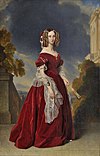 |
3 April 1812 | 11 October 1850 | Married King Leopold I of Belgium, had issue. |
| Princess Marie d'Orléans |  |
12 April 1813 | 6 January 1839 | Married Duke Alexander of Württemberg, had issue. |
| Louis, Duke of Nemours | 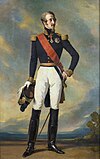 |
25 October 1814 | 26 June 1896 | Married Princess Victoria of Saxe-Coburg and Gotha, had issue. |
| Princess Françoise Louise Caroline d'Orléans | 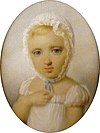 |
26 March 1816 | 20 May 1818 | Died aged two. Baptised on 20 July 1816, with Emperor Francis I of Austria as her godfather.
|
| Clémentine d'Orléans |  |
6 March 1817 | 16 February 1907 | Married Prince August of Saxe-Coburg and Gotha, had issue. |
François, Prince of Joinville |
 |
14 August 1818 | 16 June 1900 | Married Princess Francisca of Brazil, had issue. |
Charles d'Orléans |
 |
1 January 1820 | 25 July 1828 | Died aged eight. |
Henri, Duke of Aumale |
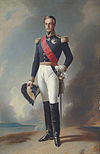 |
16 January 1822 | 7 May 1897 | Married Princess Caroline Auguste of the Two Sicilies, had issue-but no descendants survive. |
| Antoine, Duke of Montpensier | 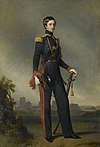 |
31 July 1824 | 4 February 1890 | Married Infanta Luisa Fernanda, Duchess of Montpensier , had issue.
|
Ancestry
| Ancestors of Louis Philippe I | ||||||||||||||||||||||||||||||||||||||||||
|---|---|---|---|---|---|---|---|---|---|---|---|---|---|---|---|---|---|---|---|---|---|---|---|---|---|---|---|---|---|---|---|---|---|---|---|---|---|---|---|---|---|---|
| ||||||||||||||||||||||||||||||||||||||||||
See also
- Louis Philippe style
- List of works by James Pradier
- Paris under Louis Philippe
- Lieutenant-General (France)
- Origins of the French Foreign Legion
- Port Louis Philippe (Akaroa)
Namesakes
- Louis Philippe, Crown Prince of Belgium (1833–1834), grandson by his daughter Queen Louise of the Belgians
- Luís Filipe, Prince Royal of Portugal (1887–1908), great-great-grandson and heir to the Portuguese Throne
Notes
- ^ Louis Philippe's 13 August 1830 Ordinance, relative to the surname (nom) and titles of his children and of his sister:
Ordonnance du roi qui détermine les noms et titres des princes et princesses de la famille royale.
- LOUIS PHILIPPE ROI DES FRANÇAIS, à tous présens et à venir, salut.
- Notre bien-aimé fils aîné, le duc de Chartres, portera, comme prince royal, le titre de duc d'Orléans.
- Il sera fait, en conséquence, sur les registres de l'état civil de la Maison royale, dans les archives de la Chambre des Pairs, toutes les rectifications qui résultent des dispositions ci-dessus [...]
References
Citations
- ISBN 0-8504-5088-8.
- ^ "Kom Inn! (NRK-TV Norsk Rikskringkasting)". tv.nrk.no. 12 September 1981.
- ^ Saucier, Corinne L. (1943). History of Avoyelles Parish. p. 27.
- ^ Compare: "Ealing and Brentford: Education - British History Online". www.british-history.ac.uk.
Great Ealing school was founded in 1698. [...] A Mr. Pierce was succeeded as master in 1768 by his son-in-law the Revd. Richard Badcock Shury, rector of Perivale, whose son-in-law the Revd. David Nicholas became headmaster in 1791. Nicholas (d. 1829) and his sons the Revd. George, who left in 1837, and the Revd. Francis Nicholas spent large sums on buildings and achieved a wide reputation. [...] The curriculum was that of a public school, [...] and Louis-Philippe, later king of the French, taught geography and mathematics there in the early 19th century.
- OL 9691791M.[page needed]
- ^ (subscription or UK public library membership required)
- ^ Dyson. C.C, The Life of Marie Amelie Last Queen of the French, 1782–1866, BiblioBazaar, LLC, 2008.
- ^ de Flers, 1891; pp. 75–76, 88
- ^ de Flers, 1891; pp. 78–81
- ^ de Flers, 1891; p. 88
- ^ "Louis-Philippe Biography". The Biography.com Website. Retrieved 13 May 2014.
- ^ a b Price, 1993; p. 168
- ^ Fortescue, 2005; p. 29
- ^ Fortescue, 2005; p. 28
- ^ Price, Roger (1993). A Concise History of France. Cambridge University Press. p. 166.
- ^ Fortescue, 2005; p. 27
- JSTOR 2548358.
- ^ de Flers, 1891; pp. 137–138
- ^ Mansel, Philip (2003). Paris Between Empires: Monarchy and Revolution 1814–1852. St. Martin's Press. pp. 283–285.
- ^ de Flers, 1891; pp. 106–109
- ^ "Louis-Philippe King of France". www.britannica.com. Retrieved 8 June 2019.
- ^ Hugo, Victor. "III. Louis Philippe". Les Miserables – via Online-literature.com.
- OL 19801431W.
- ISBN 978-0-3122-9479-3.
- ^ Bredow, Gabriel G.; Venturini, Carl (1837). Chronik des neunzehnten Jahrhunderts.
- ^ Bouveiron & Fieschi, 1835; p. 32
- ^ de Flers, 1891; 162–166
- ^ Royal Victoria Hotel – Historical Hastings Wiki, accessdate: 22 May 2020
- ^ Teulet, Alexandre (1863). "Liste chronologique des chevaliers de l'ordre du Saint-Esprit depuis son origine jusqu'à son extinction (1578–1830)" [Chronological list of knights of the Order of the Holy Spirit from its origin to its extinction (1578–1830)]. Annuaire-bulletin de la Société de l'histoire de France (in French) (2): 111. Retrieved 24 March 2020.
- ^ "Ordre de la Légion d'honneur: Textes officiels antérieurs à 1962". france-phaleristique.com (in French). Retrieved 26 March 2020.
- ^ "Ordre royal et militaire de Saint-Louis". france-phaleristique.com (in French). Retrieved 26 March 2020.
- ^ H. Tarlier (1854). Almanach royal officiel, publié, exécution d'un arrête du roi (in French). Vol. 1. p. 37.
- ISBN 978-8-7767-4434-2.
- ^ "Herzogliche Sachsen-Ernestinischer Hausorden", Adreß-Handbuch des Herzogthums Sachsen-Coburg und Gotha (in German), Coburg, Gotha: Meusel, 1843, p. 6, retrieved 12 March 2020
- ^ Militaire Willems-Orde: Bourbon, Louis Phillip prince de (in Dutch)
- ^ "Caballeros existentes en la insignie Orden del Toison de Oro". Guía de forasteros en Madrid para el año de 1835 (in Spanish). En la Imprenta Nacional. 1835. p. 73.
- ^ "Nichan ad-Dam, ou ordre du Sang, institué... – Lot 198".
- ^ Almanacco reale del Regno delle Due Sicilie per l'anno ... dalla Real Tipografia del Ministero di Stato della Cancelleria Generale. pp. 459, 463.
- ^ Shaw, Wm. A. (1906) The Knights of England, volume=I, London, p. 57
- ISBN 978-0-1432-0410-7.
- ^ a b Buick, T. Lindsay (1928). The French at Akaroa. p. 51.
Bibliography
- Aston, Nigel (October 1988). "Orleanism, 1780–1830". History Today. 38 (10): 41–47.
- Bastide, Charles (1927). "The Anglo-French Entente under Louis Philippe". Economica (19): 91–98. JSTOR 2548358.
- Beik, Paul Harold (1965). Louis Philippe and the July Monarchy. Van Nostrand. OL 40215892M.
- Collingham, H.A.C.; Alexander, R. S. (1988). The July Monarchy: A Political History of France, 1830–1848. Longman. OL 2394831M.
- OL 6918316M.
- Fortescue, William (2005). France and 1848: The End of Monarchy. Routledge. p. 27. ISBN 978-0-4153-1462-6.
- Howarth, T.E.B. Citizen-King: The Life of Louis Philippe, King of the French (1962).
- Jardin, Andre, and Andre-Jean Tudesq. Restoration and Reaction 1815–1848 (The Cambridge History of Modern France) (1988).
- Lucas-Dubreton, J. The Restoration and the July Monarchy (1929).
- Newman, Edgar Leon, and Robert Lawrence Simpson. Historical Dictionary of France from the 1815 Restoration to the Second Empire (Greenwood Press, 1987) online edition Archived 28 June 2011 at the Wayback Machine.
- Porch, Douglas. "The French Army Law of 1832." Historical Journal 14, no. 4 (1971): 751–69. online.
External links
 Media related to Louis Philippe I at Wikimedia Commons
Media related to Louis Philippe I at Wikimedia Commons- . Encyclopædia Britannica. Vol. XV (9th ed.). 1883.
- Caricatures of Louis Philippe and others, published in La Caricature 1830–1835 (La Caricature Gallery)
- ^ Abdicated on the same day







